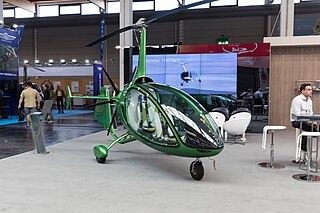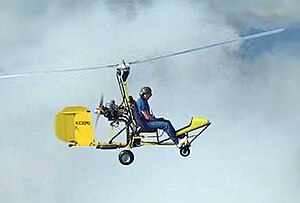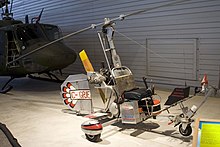
An autogyro, or gyroplane, is a class of rotorcraft that uses an unpowered rotor in free autorotation to develop lift. While similar to a helicopter rotor in appearance, the autogyro's unpowered rotor disc must have air flowing upward across it to make it rotate.
The CarterCopter is an experimental compound autogyro developed by Carter Aviation Technologies in the United States to demonstrate slowed rotor technology. On 17 June 2005, the CarterCopter became the first rotorcraft to achieve mu-1 (μ=1), an equal ratio of airspeed to rotor tip speed, but crashed on the next flight and has been inoperable since. It is being replaced by the Carter Personal Air Vehicle.

The McDonnell XV-1 is an experimental Convertiplane developed by McDonnell Aircraft for a joint research program between the United States Air Force and the United States Army to explore technologies to develop an aircraft that could take off and land like a helicopter but fly at faster airspeeds, similar to a conventional airplane. The XV-1 would reach a speed of 200 mph, faster than any previous rotorcraft, but the program was terminated due to the tip-jet noise and complexity of the technology which gave only a modest gain in performance.

The Cierva C.8 was an experimental autogyro built by Juan de la Cierva in England in 1926 in association with Avro. Like Cierva's earlier autogyros, the C.8s were based on existing fixed-wing aircraft fuselages – in this case, the Avro 552.

The Bensen B-7 was a small rotor kite developed by Igor Bensen in the United States in the 1950s and marketed for home building. It was a refined to be a slightly larger version of the B-6, replacing the skids with a tricycle undercarriage, and adding a single large fin to the rear of the aircraft.

The Pitcairn PA-34 and Pitcairn PA-33, given the United States Navy (USN) designation Pitcairn OP-2 and United States Army designation Pitcairn YG-2 respectively were reconnaissance autogyros designed and built in 1936 for evaluation.

The Scheibe SF-25 Falke is a German touring motor glider developed from the earlier Bergfalke glider by Scheibe Flugzeugbau. Since May 2006 the business has been run by Scheibe Aircraft GmbH.

The Wallis WA-116 Agile is a British autogyro developed in the early 1960s by former Royal Air Force Wing Commander Ken Wallis. The aircraft was produced in a number of variants, one of which, nicknamed Little Nellie, was flown in the 1967 James Bond film You Only Live Twice. Little Nellie is currently on static display at The Shuttleworth Collection, Old Warden, Bedfordshire in the UK.

The KB-2 Freedom Machine is an autogyro designed by Ken Brock based on the designs of the Bensen B-8.
The CSIR SARA II is a South African two-seat experimental autogyro designed and built by the Aeronautics Research Unit of the Council for Scientific and Industrial Research.

The Sport Copter Lightning is an American autogyro, designed and produced by Sport Copter of Scappoose, Oregon. The aircraft is supplied as a kit for amateur construction.

The AutoGyro MT-03 is a German autogyro, designed and produced by AutoGyro GmbH of Hildesheim. The aircraft is supplied as a complete ready-to-fly-aircraft.
The Midwest Hornet is an American autogyro that was designed by Don Shoebridge and made available by Midwest Engineering & Design in the form of free plans for amateur construction.
The Taggart GyroBee is an American autogyro that was designed by Ralph E. Taggart of Michigan State University and made available as free documentation. The aircraft is also produced in kit form by Star Bee Gyros of Worcester, Massachusetts for amateur construction.
The Bannick Model T of the Air was the first of series of homebuilt autogyro designs.

The DTA J-RO (transl. gyro) is a French autogyro designed and produced by DTA sarl of Montélimar. The aircraft is supplied complete and ready-to-fly.

The ELA 09 Junior is a Spanish autogyro designed and produced by ELA Aviación of Córdoba, Andalusia, introduced in the mid-2010s. The aircraft is supplied complete and ready-to-fly.

The Niki Kallithea is a Bulgarian autogyro designed and produced by Niki Rotor Aviation of Pravets, introduced in 2011. The aircraft is supplied complete and ready-to-fly.

The Russian Gyroplanes Gyros-2 Smartflier is a Russian autogyro designed and produced by Russian Gyroplanes of Zhukovsky, Moscow Oblast. The aircraft is supplied complete and ready-to-fly.
The Trixy Trixformer is an Austrian roadable aircraft autogyro/electric motorcycle designed and produced by Trixy Aviation Products of Dornbirn, introduced in 2014. The vehicle is supplied complete and ready-to-fly.
















